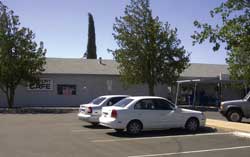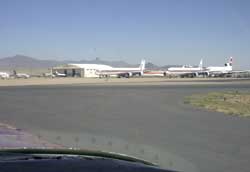|
|
 |
| SW Aviator Magazine is available in print free at FBOs and aviation-related businesses throughout the Southwest or by subscription. |

|
 |

|
 |
 |
 |
|
The web's most comprehensive database of Southwest area aviation events.
|

|
 |

|
 |
|
Featured Site:
|
|
|
 |
|
A continuosly changing collection of links to our favorite aviation related web sites.
|

|
 |

|
 |
 |
|

|
AN AIRPORT CLASSIC
|
|
Kingman Airport Café
|
 Story and photos by Karl Gross Story and photos by Karl Gross
Most of us have flown into Las Vegas – at least for business, right? Like many others, in the past I treated Kingman as just a VOR on the way somewhere else, not a destination by itself. But one visit to the Kingman airport and the cleverly named Kingman Airport Café and you too may start planning your flight so you can fill up on some good classic airport food before you have to deal with the Las Vegas Class B airspace.
Kingman has been ‘on the way’ to somewhere for many years. In the 1850s the experimental Camel Corps crossed through the area, and not long after that the mineral wealth of the surrounding areas was discovered and serious settlement began as people traveled to and from the mines. By the 1880s the town had been firmly established where it is today. Founded in 1929, the original Kingman airfield was the first commercial airport in Arizona, established and dedicated by no less than Charles Lindberg and Amelia Earhart.
With the onset of WWII, Kingman Army Air Field was established at the site of today’s airport.* As you fly in and walk around you will easily pick out features of the old army field, not to mention one of the oldest remaining control towers, high on its steel legs just north of the GA tie down area. This structure should be designated a historical landmark if for no other reason that it is the best remaining example of an intact tower of this age I have discovered in the hundreds of airports I have visited.

The Kingman airport (IGM) is just south of old Route 66, about five miles northeast of downtown Kingman. The airport is at 3449 feet, and located in a wide valley. There are two major runways in use, 3/21 and 17/35; each are over 6500 feet long with plenty of room for takeoffs on summer days when density altitude climbs to over 5000 feet. As they say on the ATIS on 119.275, “Check density altitude” at this airfield. Airport traffic uses 122.8 and the traffic count is high enough to make it important to call when getting close. The Kingman VOR (IGM) is located on the field and operates on 108.8 MHz. The airport is shown on the Phoenix Sectional and has instrument approaches that are often in use by trainers from the Las Vegas, Prescott, and Phoenix areas.
The airport terminal has a rental car counter if you want to explore the area, and two FBOs are located on the field. Air’Zona Aircraft Service (928-757-7744) and Kingman Aero Services (928-757-1335) each have 100LL and Jet fuel, a self-serve pump is located just to the east of the terminal, but be careful with the security area established near it when taxiing in for fuel. Being an interstate town (I-40), Kingman has numerous hotels and motels if you decide to spend the night, including almost every major chain. All the people who work on the field have been helpful and friendly on my many stops for food and fuel over the past few years.
Just to the east of the old control tower in the main terminal building is the Kingman Airport Café. The café is an airport classic, too. Dozens of airplane pictures adorn the ceiling and walls, and the view looks right at the ramp area if you want to look at the real thing. The post 9/11 changes have blocked the view of the turbo-props that deliver passengers a few times a day, but there is still plenty to see. The café even has a covered outside seating area for when it is nice enough to sit outside and listen to the airplanes, too.
The café is open from 6 a.m. until 2 p.m. daily, serving breakfast until 11 a.m. each day. The menu has all the required classics – New York Steak and Eggs for just over $7, Omelets for less than $6, Hamburgers for about $5, and Patty Melts for around $5.50. A kids menu will fill the little ones up for less than $5 each. Personal favorites, the Patty Melt and the Rueben, have had me wondering about gross-weight and CG issues more than once.
The café also has a nice selection of basic Mexican food, the kind everyone in the rural Southwest expects. But at the Kingman Airport Café it is too good to take for granted, and you will see a lot of locals coming in for breakfast and lunch. I have never gone wrong at a restaurant with this many police cars regularly visiting. Chicken Fajitas and Carne Asada are always good for those of you passing through who want a sample. The owners are not new to the restaurant business, and it shows in the consistently good service and food. They formerly operated a local favorite in town, but migrated out to the Kingman Airport and Industrial Park to take advantage of the growing employee pool as well as the airport business. The café can be reached at 928-757-4420.
While flying in the area, there are plenty of sites to see. One of the longest stretches of old Route 66 that remains in use today starts in Kingman and reaches east almost to Ash Fork. The route traverses the high valleys and ridges of the southwest corner of the Colorado plateau. A flying author recently chronicled the old highway from the air, and this remaining stretch of the old concrete is an excellent place to see a bit of the route yourself. With its history and scenery, it is one of the original IFR (as in “I follow roads”) paths across the U.S.A. and you will be flying a historic route traveled for most of the last century.

After WWII, the Kingman Army Air Field served as a storage depot for over 7000 returning airplanes. The typical dry Arizona climate served well then, and continues to do so today, with dozens of airplanes stored on the ramps awaiting a return to service or disassembly for parts. They range from a wide body tri-jet to Beechcraft and Brasilia turbo-props. Enjoy the views of all the aluminum as you taxi in – the storage areas are closed to visitors.
The next time you are headed to Las Vegas or anywhere else in or over northern Arizona consider a food and fuel stop at the Kingman airport – you won’t be sorry you came.
Karl Gross grew up not too far east of Kingman in Flagstaff and later in Jerome, Arizona. He now commutes around the West in an older Mooney and can usually be found eating in an airport restaurant if not in the air.
*For more information about the history of the Kingman Airport, visit geocities.com/sgtroc462.
|
Click here to return to the beginning of this article.  |
|